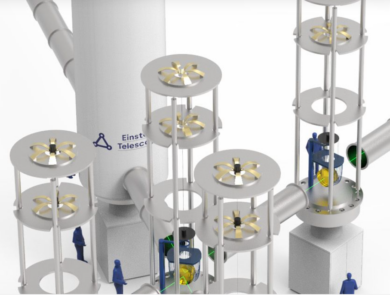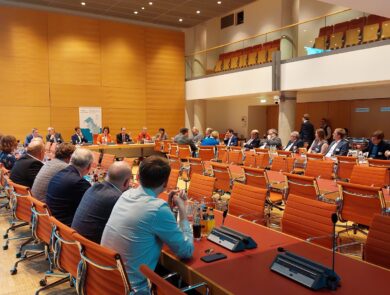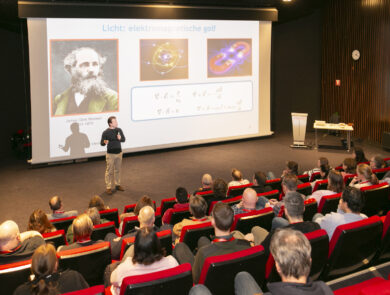Science and industry need each other

It’s a special sight: Jan Visser’s desk at Nikhef is full of open little boxes with carefully categorised business cards. I spoke to him the day after a meeting in Maastricht. During that meeting, several parties discussed how they can make sure that companies are more involved in the Einstein Telescope. I asked him about his job and what it actually looks like, the collaboration between large scientific infrastructures and industry.
You work as coordinator for industrial contacts at Nikhef. What exactly does that mean?
I spend a large part of my time on things related to CERN. On the one hand, my job is to find companies with the right core competencies for CERN tenders. These companies are most likely to be able to submit competitively. To do this, I need to understand what CERN needs. I also have to understand the Dutch companies well and know what they excel in. The other part is knowledge transfer. To this end, I coordinate CERN’s contacts with three Dutch business incubators. Together, we explore how CERN’s technology can be used for start-ups and if there are existing companies that can use these technologies.
In addition to working for CERN, I support Nikhef colleagues with other tenders. Others are in charge of purchasing mechanics and electronics. But sometimes they are looking for something special. Then they usually come to me. Next to this, large research projects often need industrial support. Here I help out as well. And, of course, I’m involved in the Einstein Telescope and related projects, such as ETpathfinder and E-TEST.
Why is collaboration between science and industry important?
We cannot build large scientific instruments without industry. Some components for example, require mass production. We can make certain parts ourselves in small quantities, but not on such a large scale. There are also parts that we cannot make ourselves. This has to be done by industry. Thus, industry is indispensable for science.
But it also works the other way around. Science often requires companies to do things they have not done before. In this way we really challenge them. This results in new insights for products, entirely new products, or surprising new applications. I think the best example of this is the current mobile phone. Both the worldwide web and the touchscreen have been developed at CERN. And now there’s hardly anyone who doesn’t have one of those things in his or her pocket.
How can companies benefit from being involved in a scientific infrastructure?
It starts very simply with ‘making money’. Furthermore, you will be challenged because you are going to do things you haven’t done before. This can for example lead to new products. But there is also a marketing aspect to it. If you deliver something for CERN for example, it will give you a kind of quality mark. Companies also consider it a way of keeping creative and resourceful employees on board, and of attracting new talent. Projects like this can really challenge your employees.
What does it look like, the collaboration between a scientific infrastructure and a company?
Actually, you have three forms. The first one is ‘craftmanship’. This means that a company makes something to order. It sounds simple, but it’s not. It’s often made-to-order work that you have to think about very carefully first.
Then you have the engineering part, which is often about the larger systems. At CERN, this is fairly limited, because the institutes involved develop a lot themselves. In space travel, for example, this is often outsourced. As a result, there are quite a few companies working in aerospace engineering.
Then there is a form that is more focused on the long term: you form a consortium with companies and institutes and start working together. This also happens at CERN. However, in the Netherlands we are not doing this yet. We are now looking at the various technology roadmaps in the country, in order to identify more collaboration opportunities. What are the necessary technologies? And how do they fit in with the Dutch long-term plans for key technologies? And which companies would like to deploy this strategically? We do this for CERN, but also for the Einstein Telescope.
How does such a collaboration start?
It often starts with a problem that we cannot or do not want to solve on our own. When this happens, I connect to our network to see who could do this. This can be done at Holland@CERN, at the Precision Fair, or elsewhere. I try to bring CERN’s buyers and technicians into contact with companies. The ILO-network also organizes afternoons for companies, and afternoons on specific themes. Recently we had an Einstein Telescope afternoon at VDL and many companies were invited. We met one company here who is now going to do a review. Sometimes a company reaches out to us spontaneously, but usually we connect through these kinds of meetings.
What are the biggest challenges for collaboration between science and industry?
It is difficult to find the right match for solving complex challenges together. Science usually has very specific requirements. And you have to find companies that can do exactly what is needed, or are open to learning and developing this. Another problem is the difference between internal and external hourly rates. If that difference is too big, it is usually solved internally. It would help if more funding was available for the preliminary process. Then cooperation would be easier.
There is another challenge: physicists often start developing something before the specifications are clear. That makes it difficult to assign a task or question to a company. That is why you need close collaboration and you really have to help each other out.
Finally, science sometimes underestimates what industry can do. That’s why I’m encouraging scientists to invite a company consultant earlier on in the process. That can be of great benefit.
What does it take to make a collaboration successful?
We have had good experiences with a number of companies. Often, it’s the smaller companies, with a CEO who thinks Big Science is cool and isn’t afraid to take some risks. These companies do not only think of direct profit, but also value learning new things and being challenged. We need people with such a long-term vision.
Have many companies already shown an interest in the Einstein Telescope?
There is a lot of interest, and that’s great! We are still in the R&D phase and are looking for companies that can and want to develop very specific things. Not all companies are a good match for that, so that can be a challenge. But there are plenty of companies in the region that can do something in the long term. That is why it is important to be in contact with each other. I also say to everyone “If you hear or see interesting companies, just send me an email and I will get in touch.” It is always good to get to know each other and see where the possibilities lie.
Would you like to explore collaboration possibilities? Then go to contact.


